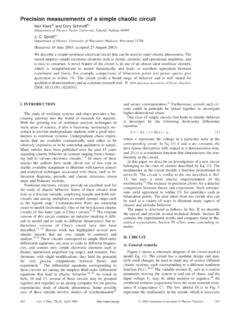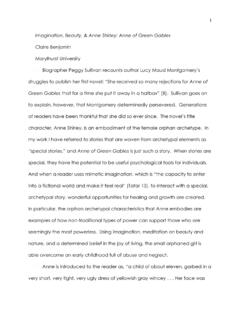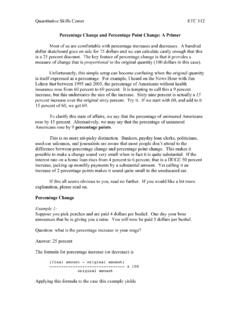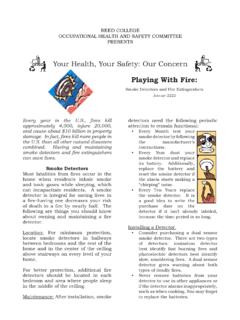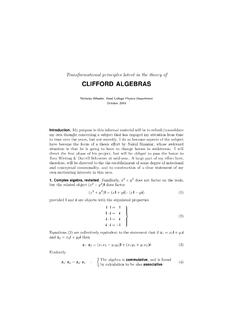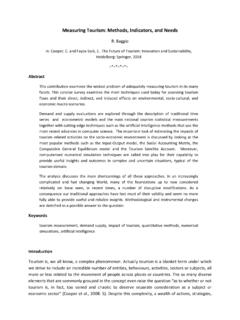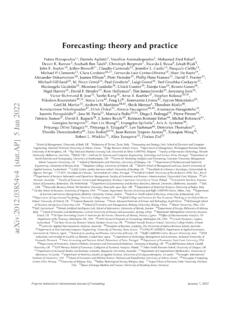Transcription of Vector Autoregression and Vector Error-Correction Models
1 CHAPTER 5 Vector Autoregression and Vector Error-Correction Models Vector Autoregression (VAR) was introduced by Sims (1980) as a technique that could be used by macroeconomists to characterize the joint dynamic behavior of a collection of varia-bles without requiring strong restrictions of the kind needed to identify underlying structural parameters. It has become a prevalent method of time-series modeling. Although estimating the equations of a VAR does not require strong identification as-sumptions, some of the most useful applications of the estimates, such as calculating impulse-response functions (IRFs) or variance decompositions do require identifying restrictions. A typi-cal restriction takes the form of an assumption about the dynamic relationship between a pair of variables, for example, that x affects y only with a lag, or that x does not affect y in the long run.
2 A VAR system contains a set of m variables, each of which is expressed as a linear func-tion of p lags of itself and of all of the other m 1 variables, plus an error term. (It is possible to include exogenous variables such as seasonal dummies or time trends in a VAR, but we shall focus on the simple case.) With two variables, x and y, an order-p VAR would be the two equations pyxtyxpt ptxtxxytxypt pxxtxxpt ptyyyxxvxyyxxv = + + + + + + += + + + + + + + ( ) We adopt the subscript convention that xyp represents the coefficient of y in the equation for x at lag p. If we were to add another variable z to the system, there would be a third equation for zt and terms involving p lagged values of z, for example, xzp, would be added to the right-hand side of each of the three equations.
3 A key feature of equations ( ) is that no current variables appear on the right-hand side of any of the equations. This makes it plausible, though not always certain, that the regres-sors of ( ) are weakly exogenous and that, if all of the variables are stationary and ergodic, 70 Chapter 4: Vector Autoregression and Vector Error-Correction Models OLS can produce asymptotically desirable estimators. Variables that are known to be exoge-nous a common example is seasonal dummy variables may be added to the right-hand side of the VAR equations without difficulty, and obviously without including additional equations to model them. Our examples will not include such exogenous variables. The error terms in ( ) represent the parts of yt and xt that are not related to past values of the two variables: the unpredictable innovation in each variable.
4 These innovations will, in general, be correlated with one another because there will usually be some tendency for movements in yt and xt to be correlated, perhaps because of a contemporaneous causal rela-tionship (or because of the common influence of other variables). A key distinction in understanding and applying VARs is between the innovation terms v in the VAR and underlying exogenous, orthogonal shocks to each variable, which we shall call . The innovation in yt is the part of yt that cannot be predicted by past values of x and y. Some of this unpredictable variation in yt that we measure by vt is surely due to yt , an exog-enous shock to yt that is has no relationship to what is happening with x or any other variable that might be included in the system.
5 However, if x has a contemporaneous effect on y, then some part of ytv will be due to the indirect effect of the current shock to x, xt , which enters the yt equation in ( ) through the error term because current xt is not allowed to be on the right-hand side. We will study in the next section how, by making identifying assumptions, we can identify the exogenous shocks from our estimates of the VAR coefficients and re-siduals. Correlation between the error terms of two equations, such as that present in ( ), usual-ly means that we can gain efficiency by using the seemingly unrelated regressions (SUR) sys-tem estimator rather than estimating the equations individually by OLS. However, the VAR system conforms to the one exception to that rule: the regressors of all of the equations are identical, meaning that SUR and OLS lead to identical estimators.
6 The only situation in which we gain by estimating the VAR as a system of seemingly unrelated regressions is when we impose restrictions on the coefficients of the VAR, a case that we shall ignore here. When the variables of a VAR are cointegrated, we use a Vector Error-Correction (VEC) model. A VEC for two variables might look like ()()0 111110110 11111011,tyytypt pytypt pyyttttxxtxpt pxtxpt pxxtttyyyxxyxvxyyxxyxv = + + + + + + + = + + + + + + + ( ) where 01ttyx= + is the long-run cointegrating relationship between the two variables and y and x are the Error-Correction parameters that measure how y and x react to deviations from long-run equilibrium.
7 Chapter 4: Vector Autoregression and Vector Error-Correction Models 71 When we apply the VEC model to more than two variables, we must consider the possi-bility that more than one cointegrating relationship exists among the variables. For example, if x, y, and z all tend to be equal in the long run, then xt = yt and yt = zt (or, equivalently, xt = zt) would be two cointegrating relationships. To deal with this situation we need to general-ize the procedure for testing for cointegrating relationships to allow more than one cointe-grating equation, and we need a model that allows multiple Error-Correction terms in each equation. forecasting and Granger Causality in a VAR In order to identify structural shocks and their dynamic effects we must make additional identification assumptions.
8 However, a simple VAR system such as ( ) can be used for two important econometric tasks without making any additional assumptions. We can use ( ) as a convenient method to generate forecasts for x and y, and we can attempt to infer infor-mation about the direction or directions of causality between x and y using the technique of Granger causality analysis. forecasting with a VAR The structure of equations ( ) is designed to model how the values of the variables in period t are related to past values. This makes the VAR a natural for the task of forecasting the future paths of x and y conditional on their past histories. Suppose that we have a sample of observations on x and y that ends in period T, and that we wish to forecast their values in T + 1, T + 2, etc.
9 To keep the algebra simple, suppose that p = 1, so there is only one lagged value on the right-hand side. For period T + 1, our VAR is 10 11110 ++++= + + += + + + ( ) Taking the expectation conditional on the relevant information from the sample (xT and yT) gives ()()()()1011110111|,|,|,|, .yTTTyyyTyxTTTTxTTTxxyTxxTTTTEy xyyx Ev xyEx xyyx Ev xy++++= + + += + + + ( ) The conditional expectation of the VAR error terms on the right-hand side must be zero in order for OLS to estimate the coefficients consistently. Whether or not this assumption is valid will depend on the serial correlation properties of the v terms we have seen that serial-ly correlated errors and lagged dependent variables of the kind present in the VAR can be a toxic combination.
10 72 Chapter 4: Vector Autoregression and Vector Error-Correction Models Thus, we want to make sure that ()11|,0jx ytt tEv v v =. As we saw in an earlier chapter, adding lagged values of y and x can often eliminate serial correlation of the error, and this method is now more common than using GLS procedures to correct for possible autocorrela-tion. We assume that our VAR system has sufficient lag length that the error term is not seri-ally correlated, so that the conditional expectation of the error term for all periods after T is zero. This means that the final term on the right-hand side of each equation in ( ) is zero, so ()()10111011|,|,.TTTyyyTyxTTTTxxyTxxTEyx yyxExx yyx++= + + = + + ( ) If we knew the coefficients, we could use ( ) to calculate a forecast for period T + 1.
